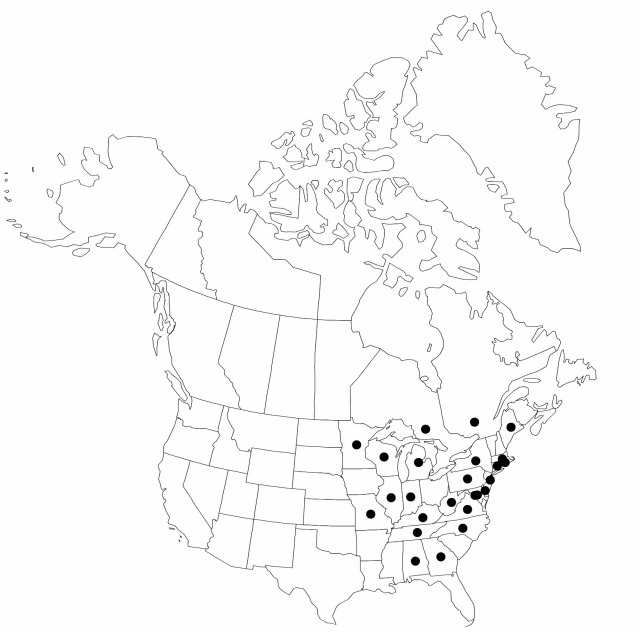Schoenoplectus purshianus
Novon 3: 202. 1993.
Plants annual; rhizomes 1 mm diam. Culms often arching (to decumbent), cylindric, 0.1–1 m × 0.5–2 mm. Leaves 1, to equaling culm; sheath fronts not pinnate-fibrillose; blade 0 or 1, C-shaped in cross section, from a mucro to longer than a sheath, 0.5–1 mm wide, smooth. Inflorescences capitate or 1 spikelet; proximal bract erect or often divergent, subterete-channeled, on longer culms of plant 1–15 cm and 1/30–1/3 of culm length. Spikelets 1–12, 5–12 × 3–4 mm; scales straw-colored to orange-brown, often lineolate-spotted, midrib region often greenish, broadly obovate, 2.5–3 × 2.5 mm, smooth, margins ciliolate distally, flanks in proximal part of spikelet each with 2–10 distinct ribs, apex rounded, entire, mucronate. Flowers: perianth members 6, rarely absent, brown, bristlelike, equaling to slightly exceeding achene, distinctly wider proximally, densely retrorsely spinulose to appressed-spinulose; anthers 0.5–0.7 mm; styles 2-fid or 2-fid and 3-fid. Achenes brown, turning blackish, thickly biconvex, sometimes plano-convex or obscurely compressed-trigonous with rounded abaxial angle, abaxial face with central bulge, obovoid, proximally rounded to distinct stipelike constriction, 1.6–2.2 × 1.2–1.5 mm, base 0.3–0.4 mm wide; beak 0.1–0.3 mm.
Distribution

Ont., Que., Ala., Conn., D.C., Del., Ga., Ill., Ind., Ky., Maine, Mass., Md., Mich., Minn., Mo., N.C., N.J., N.Y., Pa., R.I., Tenn., Va., W.Va., Wis.
Discussion
Varieties 2 (2 in the flora).
Culms of Schoenoplectus purshianus have been described erroneously as trigonous (e.g., M. L. Fernald 1950). Schoenoplectus purshianus is widely confused with S. smithii; they are clearly distinct (M. Blondeau et al. 1996; S. G. Smith and E. Hayasaka 2002). Some authors (A. A. Beetle 1942b; H. A. Gleason 1952; H. A. Gleason and A. Cronquist 1963; E. G. Voss 1972–1996) have placed S. purshianus (as Scirpus) in synonymy under Schoenoplectus smithii, and most published distributions are erroneous. The taxonomic confusion is because of the subtle nature of the diagnostic characteristics of achenes and perianth bristles, the occurrence in both species of plants with or without bristles, and overlapping involucral bract lengths and frequency of divergence. No intermediates are known; although the two species occasionally grow together they are not known to hybridize. Close examination of the perianth bristles and achenes of S. purshianus and S. smithii reveals taxonomically useful but overlooked differences as stated in the key and summarized under S. smithii.
Schoenoplectus purshianus has also been confused with its close relatives in sect. Actaegeton: Schoenoplectus juncoides (Roxburgh) Palla, S. hotarui (Ohwi) Holub, and Scirpus rockii Kükenthal, which belong to the difficult “Scirpus juncoides complex” of eastern Asia, the Pacific islands, and eastern North America; Schoenoplectus purshianus should be treated as a distinct North American species pending further research (S. G. Smith and E. Hayasaka 2002).
The name Scirpus erectus Poiret has been widely misapplied to members of that complex (see 17. Schoenoplectus erectus). The names Scirpus smithii var. williamsii (Fernald) Beetle, S. juncoides Roxburgh var. williamsii (Fernald) T. Koyama, and Schoenoplectus smithii subsp. williamsii (Fernald) Soják were misapplied by their authors to both S. purshianus var. purshianus and S. purshianus var. williamsii.
Schoenoplectus purshianus var. williamsii in recent years has been treated as Scirpus purshianus forma williamsii (Fernald) Fernald. It seems better to treat the taxon as a variety rather than a form, pending further research, because it reportedly occurs in habitats with more water-level fluctuation than S. purshianus var. purshianus (A. E. Schuyler 1972; S. G. Smith and E. Hayasaka 2002) and thus may be useful as an ecologic indicator, and because form status suggests that the taxon is trivial.
Selected References
None.
Key
| 1 | Perianth bristles present. | Schoenoplectus purshianus var. purshianus |
| 1 | Perianth bristles absent. | Schoenoplectus purshianus var. williamsii |